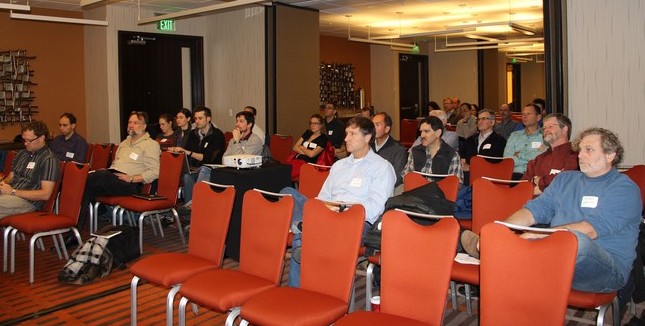AGU Fall Meeting 2013, San Francisco, USA
1Oregon State University; 2University of Iowa; 3University of Maryland; 4GEOMAR, Germany
On Sunday December 8, 2013 a diverse group of international researchers gathered at the Grand Hyatt, San Francisco for a GeoPRISMS-sponsored Mini-Workshop aimed at advancing collaborative science within the Kermadec-Havre Trough system (KAHT), part of the SCD New Zealand Focus Site. This followed from the successful New Zealand Planning Workshop held in Wellington in April 2013. The primary goal of this Mini-Workshop was to bring representatives of international groups together to discuss recent results, review ongoing science plans, and to identify area for future work under the aegis of GeoPRISMS.
Following an introduction from the organizers and short presentations by NSF and GeoPRISMS representatives, a keynote presentation by Ian Smith, University of Auckland, provided background on the KAHT system as a classic intra-oceanic arc, and emphasized some of the key science opportunities such as progressive changes in convergence rate and continental contributions along strike from North to South, the significant proportion of felsic rocks that are present, and the possibility for studies of arc initiation in older preserved arc remnants.
These opportunities were also discussed and expanded on by reports from a number of international groups that are either already working in the region or that have well advanced plans. Most of these groups are actively seeking collaborators, reinforcing the potential of the KAHT system for driving multidisciplinary collaborative research. Kaj Hoernle (GEOMAR, Germany) discussed results for upcoming cruises aimed at understanding the inception and evolution of the Vitiaz Arc that was subsequently split into the Tonga-Kermadec and Lau-Colville Ridges. These ridges offer important targets for understanding the timing of initiation and evolution of the KAHT system – particularly in comparison with recent results from the Izu-Bonin-Mariana Arc (IBM) to the North. This point was also emphasized by Mark Reagan (U. of Iowa), who summarized advances in understanding of arc initiation in the IBM – and there may be close parallels between the KAHT and IBM. Yoshi Tamura (JAMSTEC) outlined ambitious plans for ROV studies of arc initiation, origin of basalts, caldera volcanism, and hydrothermal fluids associated with submarine volcanism within the KAHT. This proposed project would be conducted by a Japanese-led team of international researchers. Adam Kent (Oregon State U.) presented results provided by Richard Wysoczanski (NIWA, New Zealand) of sampling cruises to a number of submarine KAHT volcanoes as well as a number of regional and focused geophysical surveys. Many of these data sets will provide valuable for future selection of targets for detailed study. Erin Todd (USGS) discussed trace element and isotopic variations in dredged lavas from the Havre Trough – focusing on the interplay between tectonic and magmatic processes. Erin emphasized the importance of the KAHT for resolving the effects of melting styles, tectonic settings, and mantle thermal conditions on magma production during the rifting phase of backarc basin evolution.
These presentations were followed by a number of “pop up” talks – short presentations detailing other opportunities presented by KAHT research. These included Fernando Martinez (U. of Hawaii) discussing the large difference in spreading rates between the Lau Basin and Havre Trough. Samer Naif (Scripps Institution of Oceanography) described the potential for use of marine EM techniques and Dan Bassett (U. of Oxford) discussed the interplay between structure, mechanics, and seismicity. Jessica Warren (Stanford) detailed a global data base of abyssal and forearc peridotite compositions and Ken Rubin (U. of Hawaii) and Osama Ishizuka (GSJ/AIST) showed results from recent cruises to the northern Lau and the Tonga Trench respectively, that provided additional information on the range of mantle compositions and magmatic processes in the Kermadec-Tonga system.
The final part of the workshop was spent discussing future plans for KAHT research, with a consensus that the system offers many exciting new opportunities for international collaborative research.
Go to the Mini-Workshop webpage
Reference informationGeoPRISMS Newsletter, Issue No. 32, Spring 2014. Retrieved from http://geoprisms.nineplanetsllc.com

